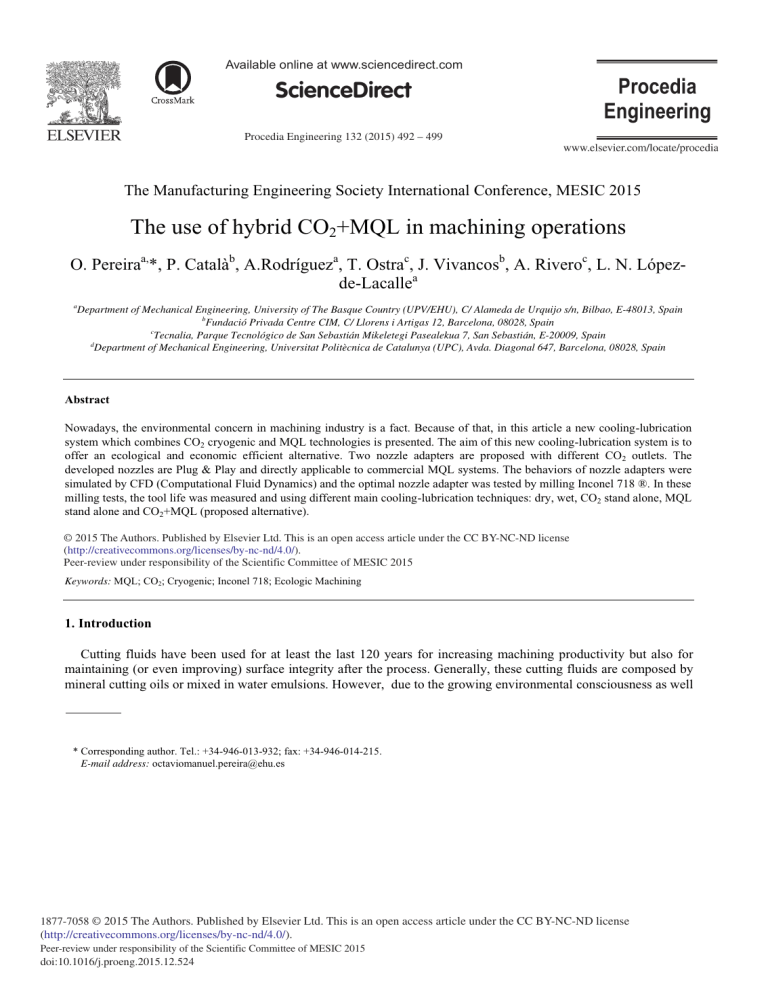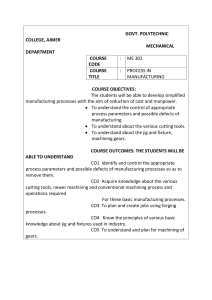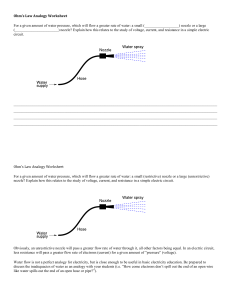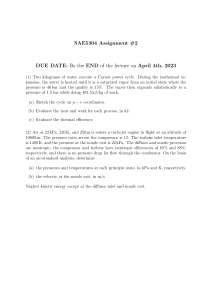
Available online at www.sciencedirect.com ScienceDirect Procedia Engineering 132 (2015) 492 – 499 The Manufacturing Engineering Society International Conference, MESIC 2015 The use of hybrid CO2+MQL in machining operations O. Pereiraa,*, P. Catalàb, A.Rodrígueza, T. Ostrac, J. Vivancosb, A. Riveroc, L. N. Lópezde-Lacallea a Department of Mechanical Engineering, University of The Basque Country (UPV/EHU), C/ Alameda de Urquijo s/n, Bilbao, E-48013, Spain b Fundació Privada Centre CIM, C/ Llorens i Artigas 12, Barcelona, 08028, Spain c Tecnalia, Parque Tecnológico de San Sebastián Mikeletegi Pasealekua 7, San Sebastián, E-20009, Spain d Department of Mechanical Engineering, Universitat Politècnica de Catalunya (UPC), Avda. Diagonal 647, Barcelona, 08028, Spain Abstract Nowadays, the environmental concern in machining industry is a fact. Because of that, in this article a new cooling-lubrication system which combines CO2 cryogenic and MQL technologies is presented. The aim of this new cooling-lubrication system is to offer an ecological and economic efficient alternative. Two nozzle adapters are proposed with different CO2 outlets. The developed nozzles are Plug & Play and directly applicable to commercial MQL systems. The behaviors of nozzle adapters were simulated by CFD (Computational Fluid Dynamics) and the optimal nozzle adapter was tested by milling Inconel 718 ®. In these milling tests, the tool life was measured and using different main cooling-lubrication techniques: dry, wet, CO2 stand alone, MQL stand alone and CO2+MQL (proposed alternative). © by by Elsevier Ltd.Ltd. This is an open access article under the CC BY-NC-ND license © 2015 2016The TheAuthors. Authors.Published Published Elsevier (http://creativecommons.org/licenses/by-nc-nd/4.0/). Peer-review under responsibility of the Scientific Committee of MESIC 2015. Peer-review under responsibility of the Scientific Committee of MESIC 2015 Keywords: MQL; CO2; Cryogenic; Inconel 718; Ecologic Machining 1. Introduction Cutting fluids have been used for at least the last 120 years for increasing machining productivity but also for maintaining (or even improving) surface integrity after the process. Generally, these cutting fluids are composed by mineral cutting oils or mixed in water emulsions. However, due to the growing environmental consciousness as well * Corresponding author. Tel.: +34-946-013-932; fax: +34-946-014-215. E-mail address: octaviomanuel.pereira@ehu.es 1877-7058 © 2015 The Authors. Published by Elsevier Ltd. This is an open access article under the CC BY-NC-ND license (http://creativecommons.org/licenses/by-nc-nd/4.0/). Peer-review under responsibility of the Scientific Committee of MESIC 2015 doi:10.1016/j.proeng.2015.12.524 O. Pereira et al. / Procedia Engineering 132 (2015) 492 – 499 493 as recent strict regulations, it is being necessary to consider new alternative cooling-lubrication systems more efficient, cheap, reliable and environmentally sustainable [1]. The amount of cutting fluids consumed by The European Union is around 320000 Tm/year [2]. 30% of this cutting fluid is estimated that is lost through leaks in circuits, or in the cleaning process of the pieces, etc. Therefore, the removal and treatment processes of cutting fluids are inefficient and finally this contamination ends up inside the alimentary chain through the pollution of rivers [3]. Furthermore, in the world there are 1,2 million of workers exposed to injurious effects of cutting fluids according to NIOSH (National Institute of Occupational, Safety and Health, USA). Among these injurious effects are skin irritation, acne, loss of pulmonary function, pneumonia and even skin or lung cancer [4, 5].In addition, the use of cutting fluids in the automotive industry supposes an impact of 17% over total manufacturing costs [6]. Besides, its treatment after its useful life is between 2 and 4 times its purchase price [7]. For all the above presented reasons the use of cutting fluids is inefficient economically as well as environmentally. An alternative system which is being studied for last 15 years is MQL (minimum quantity lubrication). Nowadays MQL is having some acceptance in manufacturing industry. This technique consists in spraying over the tool an aerosol made of biodegradable oil microparticles, so any toxicity is avoided. At the same time, the manufacturing costs are reduced because the flow rate of biodegradable oil is between 10 ml/h and 100 ml/h, that is, the oil consumption is reduced even 1000 times in some operations [8]. Although among the advantages of MQL provide a good thermal stability and better lubrication properties than other cooling-lubrication techniques, its poor cooling capacity is a clear disadvantage. Thus, in materials where cutting temperature is very high, the most part of the oil microparticles are evaporated before reaching the cutting zone, resulting both in a bad cooling and in a bad lubrication problem. To solve this MQL disadvantage some investigations have been carried out. For example, to reduce the cutting temperature it should be pointed out two methods based on spray injection with microparticles of water coated by oil. In the first method, the microparticles coated by oil are made in a 3 channel nozzle by Venturi’s effect [9]. In the second one, first water is boiled in a pressurized tank. Then, this pressurized hot water is released in a tank with oil which is at atmospheric pressure. Therefore, the water is evaporated and immediately condensed making microdroplets of water coated by oil which are conduced to the cutting zone [10]. However, the most usual and effective technique is to reduce the spray temperature. For example, in turning it should be noted the development of a tool-holder with internal refrigeration in which the spray temperature reaches around 0˚C due to an adiabatic expansion in its outlet [11]. Other way to reduce the spray temperature until -15˚C is with a system made by thermopiles. This method consists on carrying the air pipe through thermopiles before to be used to make the spray [12]. Another method to reduce the spray temperature more drastically is based on the use of a nozzle with Coanda effect, as shown in Figure 1. With this nozzle a spray cryogenized by CO 2 is achieved [13]. This nozzle is made up with three inlets and two outlets. First outlet is in the middle of the nozzle body and the other in the nozzle tip. Centre inlet carries CO 2 from the injection system to the nozzle tip. Nevertheless, other inlets carry the air and oil, respectively to an internal mix chamber where oil microparticles are generated by Venturi’s effect. These microparticles reach the nozzle tip going across the outer wall of the nozzle. Once reached the nozzle tip, microparticles are dragged by the CO2 jet. To ensure a better pulverization, this nozzle is equipped with an electrode to generate a final spray by “electrospraying”. With this nozzle, oil microdroplets temperature reaches -78ºC. Though this technique is the most effective regarding temperature reduction, it implies a considerable initial investment because it is necessary to invest a MQL and CO 2 injection system. In addition, with coanda effect it is not guaranteed that all oil microdroplets reach the nozzle tip to be pulverized again by the CO2 jet. 494 O. Pereira et al. / Procedia Engineering 132 (2015) 492 – 499 Fig. 1. Nozzle with Coanda effect. To avoid considerable initial investments, avoiding pulverization problem and maintaining lower temperatures, a new nozzle adapter are proposed and shown in Figure 2 with several configurations. The nozzle adapter is designed to combine traditional MQL systems and CO2 cryogenic technology in a “Plug and Play” system. In other words, the nozzle adaptor can be integrated in the current MQL system owned by the company, making the proposed system very attractive for machining companies and MQL users. 2. Design, CFD verification and manufacture of the nozzle adapter Initially, two types of adapters are developed. Although they have the same essence, they are different in the way of injecting the CO2 over oil microparticles sprayed by MQL. The idea is to obtain the highest possible CO2 speed reaching with oil particles to the cutting zone. Both adapters have a central connection to fix the adapter to MQL standard nozzles. These adapters have four external fits in which the liquid CO2 channels are connected. The difference between adapters is in their CO2 outlets. The first adapter (Figure 3a) has CO2 channels with convergent outlets because according to classical fluids dynamics a smaller section implies higher fluid speeds. However in the other adapter (Figure 3b), compressible fluid dynamics has been kept in mind with the aim to achieve that liquid CO2 exceeds sound speed. To get it, CO2 channels were modified with convergent-divergent outlets (Laval nozzle). Fig. 2. Proposed nozzle adapter. O. Pereira et al. / Procedia Engineering 132 (2015) 492 – 499 Fig. 3. Proposed designs. (a) Convergent nozzle; (b) Convergent-divergent nozzle (Laval). Afterwards, with the aim of verifying the most efficient design to reach the cutting zone, both designs were simulated with a CFD program (Computer Fluid Dynamics). Compressible fluids were used to simulate the convergent nozzle case (Figure 3a) and the convergent-divergent nozzle simulation too. To shorten convergence times in the simulations a structured mesh was used. This selection implies less nodes and then less computational time. For both simulations, a VOF (volume of fluid) model was selected. This model is capable of modeling two or more immiscible fluids. This model was chosen because is recommended when there are interpenetrant fluids, different fluid speeds and more than two immiscible fluids. As special feature of this model, the control volumes must be defined by a simple phase fluid or their combinations, that is, there cannot be nodes without mass. Usually, CFD models solve conservation mass, momentum and energy equations. For VOF model the conservation mass equation is changed by the volume fraction equation in each modeled fluid, in other words, the sum of all fluid fractions is the unity. For VOF model, the momentum equation was only solved in the domain and the resulting speed field is distributed by all phases. Finally, for VOF model to solve the energy equation, energy and temperature were considered as variables of mass average in each node. The turbulence model chosen was “K-ε Realizable” model because it presents substantial improvements in the flow characteristics, including a strong aerodynamic curvature and rotation when necessary. Furthermore, previous studies have demonstrated a better behavior in single fluids and flows with complex secondary characteristics, like the case studied. In table 1 the simulation conditions are summarized: Table 1. Summary table with the models used. Multiphase model Type of fluid Turbulence model Near-wall condition Turbulence intensity Convergent nozzle adapter Convergent-divergent nozzle adapter Volume of Fluid (VOF) with energy equation Compressible K-ε realizable Standard (V= 0 m/s) 5% Volume of Fluid (VOF) with energy equation Compressible K-ε realizable Standard (V = 0m/s) 5% Finally, the resolution algorithm selected to carry out the iterations was PISO algorithm (Pressure Implicit with Splitting of Operators). This algorithm was originally developed to non-iterative computation of pressure-speed in compressible instable flows. PISO algorithm implies a step indicator/predictor and two corrective steps to get a fast convergence. 495 496 O. Pereira et al. / Procedia Engineering 132 (2015) 492 – 499 Once nozzle adapters were simulated, to observe the spray expansion, flow speeds were plotted with both nozzle adapters. Initially, both nozzle adapters were manufactured with “rapid prototype” machines to follow the initial “Plug & Play” philosophy. These nozzle adapters were tested and compared with CFD results as it is shown in Figure 4. As it is shown in Figure 4, the higher flow speed is reached with the convergent-divergent nozzle but a more dispersed spray. However, although with convergent nozzle the flow speed is lower a more concentrated spray is achieved. Consequently, the nozzle adapter adequate to use in machining operations is the convergent nozzle adaptor. 3. Experimental tests Experimental tests were carried out comparing different cooling-lubrication techniques to validate the nozzle adapter selected. Tests consist on milling aged Inconel®718 (45HRC). A face milling is machined following a spiral trajectory with ae constant (except the approach and retract). After each spiral path, tool wear was been measured. Regarding cutting speed, aggressive conditions were chosen to obtain more thermal charge and thus amplifying the effects of different cooling-lubrication techniques. The experimental setup used to carry out tests is shown in Figure 5. a b Fig. 4. Simulation and test. (a) Convergent nozzle; (b) Convergent-divergent nozzle (Laval). O. Pereira et al. / Procedia Engineering 132 (2015) 492 – 499 Fig. 5. Experimental setup with nozzle adapter. Experimental tests were made with five different cooling-lubrication techniques with the same cutting conditions. A ball-nose finishing end mill was used. Table 2 summarizes tool geometry, cutting conditions and cooling-techniques tested. Table 1. Summary of experimental tests conditions. Tool ARAF – Ball nose finishing end mill Reference Ø [mm] Quality Cutting edge Vcef [m/min] ap [mm] Øef [mm] ae [mm] fz [mm] S [rpm] F [mm/min] Cooling-lubrication technique DRY CO2 MQL CO2+MQL WET PPHF 1600 08-CE1 16 2003 2 120 0,2 7,8 3 0,06 4897 588 Characteristics and description Dry machining CO2 cryogenic machining (14 bar, -80 ºC) Minimum quantity lubrication (Vegetal oil, Flow rate = 100 ml/h) MQL (100 ml/h) + CO2 (14 bar, -80ºC) Wet machining with mineral oil emulsion (6 bar) In the case of CO2 cryogenic machining it is necessary to use an injection system to inject liquid CO2 without problems in the nozzle adapter. That is because with atmospheric pressure liquid CO2 sublimates becoming in dry ice and plugging up the CO2 channels. With this system, first CO2 channels are pressurized at 10 bars with gaseous CO2. Then, liquid CO2 bottle is opened and liquid CO2 is released at 14 bar. Once finished using liquid CO2, its bottle is closed and then gaseous CO2 at 10 bar again sweeps all liquid CO2 of the system pipes. Although cryogenic machining uses CO2, it should be pointed out that the CO2 is obtained from a primary process, in which the generated CO2 would not be used again and liberated to the atmosphere without a second use. By this reason, the environment impact produced by the CO2 applied in cryogenic machining does not increases CO2 emissions. 497 498 O. Pereira et al. / Procedia Engineering 132 (2015) 492 – 499 0,25 DRY ap = 0,2 mm ae = 3 mm Z=2 CO2 0,20 Øef = 7,8 mm Vcef = 120 m/min fz = 0,06 mm MQL Vbmax [µm] CO2 + MQL WET 0,15 0,10 0,05 100% 46,7% 0,00 0 1000 2000 2000 2 67,7% 84,2% 3000 4000 6 4000 6000 10 93,5% 8000 14 5000 [mm3] [mm] [min] Fig. 6. Tool life during Inconel®718 milling. Results of tool life are shown in Figure 6. Those values are the average of the maximum flank wear of the two cutting edges. In the figure, wear is represented against material removal rate [mm³], machined length [mm], and machined time [min]. The wear reference value is 0.2 mm to consider the final tool life. Previous experiences have demonstrated that over that value, the surface integrity is not guaranteed in critical Inconel®718 components. The 100% value was assigned to wet machining. With dry machining, tool life was 46.7% respect to wet machining. CO2 cryogenic machining improved the values obtained with dry machining, reaching 67.7%. With an oil flow rate of 100 ml/h in machining with MQL, tool life increases until 84.2%. Finally connecting the CO 2 nozzle adapter, the value raises to 93.5% if it is compared with wet machining. 4. Conclusions The aim of this nozzle development is to walk towards a more productive machining industry but also more environmentally friendly. The simulations shown that a higher speed does not imply better lubrication-refrigeration because the spray generated is not sprayed totally in the cutting zone. Industrially, this development has a clear advantage. It follows the “Plug & Play” philosophy and it can be adapted easily to any MQL system with less initial investment than previous proposals developed before. In the experimental tests carried out, wet machining is the alternative which has better performance. Nevertheless, the main objective is to minimize or remove mineral oil emulsions to achieve an ecologic process more profitable. Therefore, MQL+CO2 machining is the alternative which presents the best results, reaching values over 90% in comparison with wet machining but being more environmentally friendly. Next works related with this promising “Plug and Play” MQL+CO2 system will be to machine other hard-to-cut materials (Titanium alloys used for aeronautical parts, hardened steels for bearings, etc). Acknowledgements The authors are grateful to the support received by Manunet program for the funded project BeCool, Group SPRI (Basque Country), ACCIÓ (Catalan government), Department of Economic Development and Competitiveness, O. Pereira et al. / Procedia Engineering 132 (2015) 492 – 499 FEDER funds and UPV/EHU (UFI 11/29) and the support provided by the Minister of Economy and Competitiveness (project DPI2012-36166). Authors also thank the collaboration of other industries in the area, especially Praxair for providing cryogenic gases. References [1] O. Pereira, A. Rodríguez, G. Urbikaín, A. Fernandez, A. Calleja, Tecnologías emergentes en fabricación, IMHE, 410 (2014), pp. 22-28. [2] S. Lawal, I. Choudhury, Y. Nukman, Application of vegetable oil-based metalworking fluids in machining ferrous metals- A review, International Journal of Machine Tools and Manufacture, 52 (2012) 1-12. [3] G. Byrne, D. Dornfeld, B. Denkena. Advancing cutting technology. CIRP Annals - Manufacturing Technology, 52 (2003) 483-507. [4] K-H. Park, J. Olortegui-Yume, M-C.l Yoon, P. Kwon, A study on droplets and their distribution for minimum quantity lubrication (MQL). International Journal of Machine Tools and manufacture, 50 (2010) 824-833. [5] M. Huseyin Cetin, B. Ozcelik, E. Kuram, E. Demirbas, Evaluation of vegetable based cutting fluids with extreme pressure and cutting parameters in turning of AISI 304L by taguchi method, Journal of Cleaner Production, 19 (2011) 2049-2056. [6] F. Klocke, G. Eisenblätter, Dry cutting. CIRP Annals - Manufacturing Technology, 46 (1997) 519-526. [7] A. Shokrani, V. Dhokia, S.T. Newman, Environmentally conscious machining of difficult-to-machine materials with regard to cutting fluids, International Journal of machine Tools and Manufacture, 57 (2012) 83-101. [8] D. de Jesús Oliveira, L.G. Guermandi, E.C. Bianchi, A.E. Diniz, P.R. de Aguiar, R.C. Canarim, Improving mínimum quantity lubrication in CBN grinding using compressed air Wheel cleaning, Journal of Materials Processing Technology, 212 (2012) 2559-2568. [9] F. Itoigawa, T.H.C. Childs, T. Nakamura, W. Belluco, Effects and mechanisms in minimal quantity lubrication machining of an aluminum alloy, Wear, 260 (2006) pp. 339-344. [10] T. Wakabayashi, S. Suda, I. Inasaki, K. Terasaka, Y Musha, Y. Toda, Tribological action and cutting performance of MQL media in machining of aluminum, CIRP Annals-Manufacturing Technology, 100 (2007) 97-100. [11] T. Obikawa, Y. Kamata, J. Shinozuka, High-speed grooving with applying MQL, International Journal of Machine Tools and Manufacture, 46 (2006) 1854-1861. [12] Y. Su, N. He, L. Li, A. Iqbal, M.H. Xiao, S. Xu, B.G. Qiu, Refrigerated cooling air cutting of difficult-to-cut materials, International Journal of Machine Tools and Manufacture, 47 (2007) 927-933. [13] V. P. Astakhov, Ecological machining: near dry machining. Mechanics of machining: FEM simulation machining, (2009), 195–223. 499




